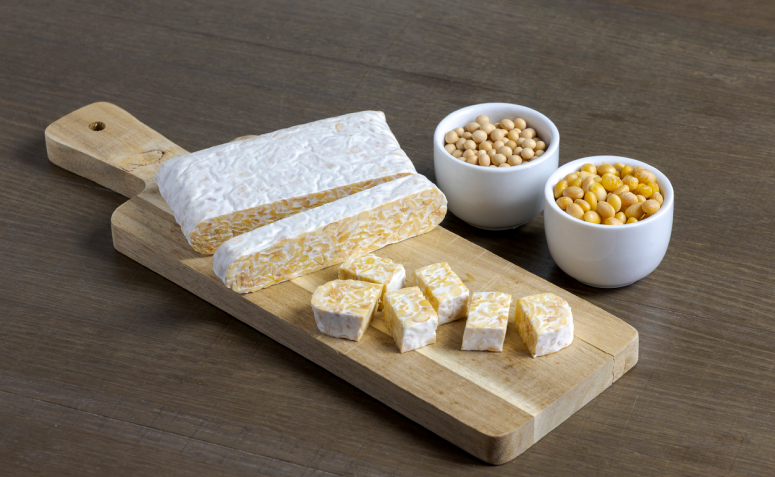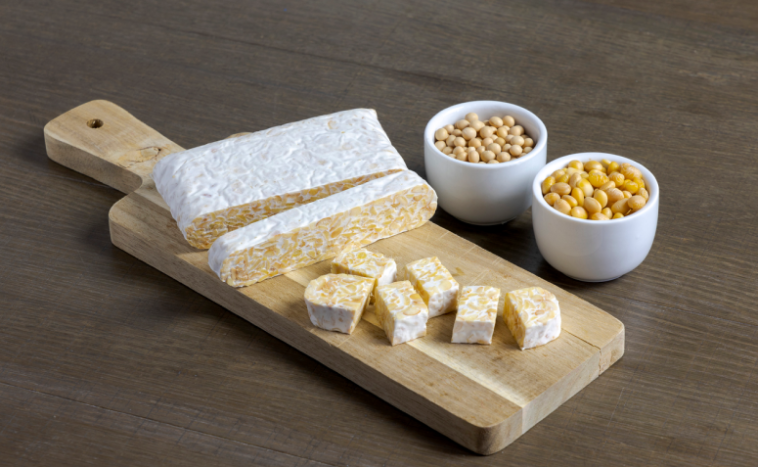
iStock
Tempeh is a food with high nutritional value and that is perfect to innovate in the menu. Below, nutritionist Flávia Hanusch (CRN-6 7462), explained what this food is and what are its benefits. Also, see at the end of the article how to prepare it and use it in recipes.
Contenus
What is tempeh
Tempeh is a fermented soybean food, traditional of Indonesia. According to nutritionist Flavia, the appearance of this food resembles a cotton-white cake, while the taste and texture are similar to mushrooms. « The fermentation process confers unique flavors, increases the nutritional values, improving the bioavailability of vitamins, minerals and isoflavones in soy, » explained the nutritionist. In addition, Flavia said that this process makes soy proteins better absorbed by humans.
Benefits of tempeh
Check out the benefits of tempeh listed by nutritionist below:
- Antioxidant activity: According to Flavia, tempeh has higher antioxidant activity when compared to soy. « This achievement can be attributed to the increased levels of polyphenols released from soy, due to the pre-treatment of soaking and boiling, with the degradation of the cell wall through enzymes secreted by the fungus Rhizopus oligosporus during fermentation, » added the nutritionist.
- It improves the functioning of the intestine: « because of the modulation of the intestinal microbiota, exerting probiotic and prebiotic function, » explained Flavia. One article (1), concluded that the consumption of tempeh and other fermented soy products increase the amounts of beneficial bacteria in the human intestinal tract.
- Excellent source of protein: according to Flavia, « when compared to other legumes, soy is the one with the highest amount of protein and less carbohydrates », that is, it is a great protein option for vegetarians and vegans. In addition, the nutritionist added that, because of fermentation, tempeh proteins are bioavailable, facilitating intestinal absorption.
- Benefits for the brain and mental health: Flavia told this happens because of the psychobiotic activities of lactic acid producing bacteria. « These bacteria increase the biological efficiency of the isoflavone and the antioxidant capacity, both with neuroprotective potential », added the professional
- Cardiovascular protection: « effect of the antioxidant capacity of isoflavones, » stated the nutritionist. Another article evaluated the consumption of soy/isoflavone (2), in which the authors concluded that the group that consumed more soy had a reduction in total cholesterol and LDL (popularly known as bad cholesterol).
There are several advantages of including tempeh in the diet. This makes it a good protein option for vegans and vegetarians as well as meat eaters.
Tempeh X tofu X seitan
All three foods are common in vegetarian or vegan diets due to their high protein content. Tempeh and tofu are derived from soybeans. According to Flavia « the main difference between them is that tofu, known as soy cheese, is not a fermented product like tempeh, as it is produced by coagulating the liquid extract of soybeans ».
Seitan, on the other hand, is derived from wheat and is popularly known as gluten meat. « The production process of seitan is quite simple. Initially, a dough is made with wheat flour and water, which after a resting period, is washed in water. This process removes all the starch, leaving only a mass of gluten (protein). » The seitan can be used in different preparations as a meat substitute.
How to make and recipes with tempeh
Want to learn how to make and use this food at home? Then take a look at the selection of recipes below:
1. How to make tempeh
Homemade tempeh fermentation is simple and takes few ingredients, yet time-consuming. After all, the soybeans must soak for 8 to 12 hours before cooking. Then, just add the vinegar and ferment for about 30 to 48 hours. The advantage is that it lasts 10 days in the refrigerator and up to 6 months in the freezer. See all the details in the video.
2. Grilled tempeh
The first step in this recipe is to marinate the tempeh in a mixture of water, shoyu, ginger, bay leaf, salt and olive oil for about 4 hours. To prevent it from getting wilted, the tip is to dry it before grilling, season it with salt and black pepper and it’s done! It’s worth a try!
3. Broccoli with tempeh
This is a surefire recipe for those with limited time in the kitchen. Here, grilled tempeh is combined with broccoli and a soy-based sauce. It’s only a few items, but it guarantees a tasty dish for your meal.
4. Tempeh with shimeji
In this recipe, tempeh is sauteed in a pan with shimeji. To close the dish with a golden key, the tip is to use a sauce made with dashi, vinegar, sake mirim and shoyu. Check out the video to see the full recipe.
5. Tempeh stir fry

iStock
Quite versatile, this scramble goes well at different times of the day and can be combined with other foods of your choice. The recipe only takes tempeh, garlic, oil, smoked paprika, shoyu, lemon juice, scallions, and water. Check the step by step instructions and try it out.
6. Tempeh skewer
The last recipe on this list is perfect for those looking for a quick and convenient snack option. Here, tempeh is cut into strips and marinated with shoyu, agave, toasted sesame oil, dijon mustard, ginger, garlic, and nirá. Then, it is just skewered on sticks and grilled.
How about including tempeh in your diet? This is a nutritious ingredient and ensures variety to the menu. And if you like to preserve food, learn how to freeze bananas to avoid waste.



